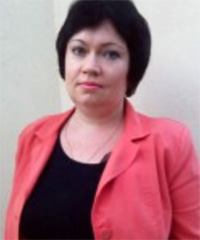|
  UDC 338.45.01; JEL E61, F43, L50
UDC 338.45.01; JEL E61, F43, L50
Pasinovych, I. I., & Sych, O. A. (2019). Industrial'na polityka yak drayver ekonomichnoho zrostannya: dosvid krayin-chleniv Yevropeys'koho Soyuzu dlya Ukrayiny [Industrial policy as a driver of economic growth: experience of European Union member states for Ukraine]. Rehional'na ekonomika - Regional Economy, 91 (1), 56-64. DOI: https://doi.org/10.36818/1562-0905-2019-1-7. [in Ukrainian].
Sources: 12
Authors
Pasinovych Iryna IhorivnaPh.D. of Economics
Associate Professor of the Department of economic theory of the Faculty of Finance Management and Business of the Ivan Franko National University of Lviv
Contacts:  irynapasinovych@ukr.net, irynapasinovych@ukr.net,  fms.dep.financial@lnu.edu.ua, fms.dep.financial@lnu.edu.ua,  iryna.pasinovych@gmail.com iryna.pasinovych@gmail.com
Webpages:      

Sych Olha AnatoliyivnaPh.D. of Economics, Associate Professor
Associate Professor of the Department of state and local finances of the Faculty of Finance Management and Business of the Ivan Franko National University of Lviv
Contacts:  olga.sych.lviv@gmail.com olga.sych.lviv@gmail.com
Webpages:     
ResumeThe article analyzes the experience of reforming of industrial policy of the EU member states on the way to sustainable economic development. Based on the conducted analysis the priority areas of high added value in Ukraine are outlined: transport, aerospace, energy engineering, production of equipment for alternative energy, including new materials and energy storage devices; production of weapons, military and special equipment; information and communication technologies. The development of the diversified and high-tech industries, especially the processing industry, is the key to ensuring the economic growth in Ukraine. The de-industrialization in Ukraine in recent years has been slowing down the movement towards the stable and sustained growth. To estimate trends in the structure of Ukraine’s GDP and their impact on economic growth, the taxonomic indicator of development level has been calculated. The units of the statistical aggregate (data from Germany, Poland and Ukraine) were mapped. The relative position of the state was determined as the distance from the statistical aggregate unit to the selected reference base (reference point). The smaller the value of the taxonomic indicator of development is, the closer the country is to the standard. The indicators of GDP, GDP growth rate and the share of industrial production belong to stimulants; the level of inflation and the share of agriculture in GDP - to disincentives. The corresponding calculations permit to draw the following conclusions: - Poland was the closest to the standard in 2000 (index 0.650), although Ukraine demonstrated at that time the highest growth rates and the biggest share of industry in GDP; - in 2017 the gap was increasing - Ukraine was inferior to both countries (with indicators 0.325 and 0.336), due to lower rates of economic growth and a decrease in the share of industrial production against the backdrop of inflationary phenomena. Ukraine should take into account that no country focused on agricultural development has succeeded in economic development. Progressive foreign experience can highlight the criterion of positive changes - an increase in the proportion of technologically complex productions with high added value in the structure of reproduction.
Keywords:economic growth, industrial policy, industrialization, deindustrialization, EU countries, taxonomic development index
References- Danylyshyn, B. M. (2017, Dec 1). Yak Ukrayini povernutysya v klub promyslovo rozvynenykh krayin [How to return to the club of industrialized countries]. Dzerkalo Tyzhnya – Mirror of the Week, 46. [in Ukrainian].
- Pavlyuts, D. (2015). My vvazhaly, shcho kryza − velycheznyy shans ochystyty upravlins’ku systemu [We thought that the crisis was a huge chance to clear the management system]. Ukrayins’kyy tyzhden’ – Ukrainian Week, 43(415). [in Ukrainian].
- Vyshnevskyy, V. P. (Ed.), Amosha, O. I., & Zbarazska, L. O., et al. (2014). Promyslovist’ i promyslova polityka Ukrayiny 2013: aktual’ni trendy, vyklyky, mozhlyvosti [Industry and industrial policy of Ukraine 2013: actual trends, challenges, opportunities]: Scientific and analytical report. Donetsk: Institute of Industrial Economics of NAS of Ukraine. [in Ukrainian].
- Amosha, O. I. (Ed.), Bulyeyev, I. P., Zemlyankin, A. I., Zbarazska, L. O., & Kharazishvili, Yu. M., et al (2017). Promyslovist’ Ukrayiny – 2016: stan ta perspektyvy rozvytku [Industry of Ukraine – 2016: the state and prospects of development]: Scientific and analytical report. Kyiv: Institute of Industrial Economics of NAS of Ukraine. [in Ukrainian].
- Lichtblau, K., Matthes, J., Fritsch, M., Bertenrath, R., Grömling M., & Busch, B. (2014, Jan 28). Industry as a growth engine in the global economy. Final Report. German Economic Institute: Website. Retrieved from https://www.iwkoeln.de/studien/gutachten/beitrag/karl-lichtblau-juergen-matthes-manuel-fritsch-roman-bertenrath-michael-groemling-berthold-busch-industry-as-a-growth-engine-in-the-global-economy-142508.html
- Rodrik, D. (2015). Premature deindustrialization. Cambridge. Retrieved from https://drodrik.scholar.harvard.edu/files/dani-rodrik/files/premature_deindustrialization_revised2.pdf
- Koval, O. (2018, Feb 2). Na shlyakhu do novoyi industrializatsiyi [On the way to a new industrialization]. Dzerkalo tyzhnya – Mirror of the week, 4. [in Ukrainian].
- Hirshveld, A., & Salikhova, O. (2018, May 15). Areopah promyslovoho renesansu [Areopag of industrial renaissance]. Livyy bereh – Left Bank. [in Ukrainian].
- Ovdenko, L. P. (Ed.) (2011). Promyslovist’ Ukrayiny [Industry of Ukraine]: Statistical publication of 2007-2010. Kyiv. [in Ukrainian].
- Petrenko, I. S. (Ed.) (2016). Promyslovist’ Ukrayiny [Industry of Ukraine]: Statistical publication of 2011-2015. Kyiv. [in Ukrainian].
- World Development Indicators: Structure of output 2010-2017 (2017). The World Bank: Website. Retrieved from http://wdi.worldbank.org/table/4.2
- Pasinovych, I. R., & Sych, O. A. (2013). Finansovi chynnyky aktyvizatsiyi ekonomichnoho zrostannya [Financial factors for boosting economic growth]. In Zęszyty naukowe. Wspólczesne problemy zarządzania. Rynki finansowe i finance przedsiębiorstw [Science notebooks. Contemporary management problems. Financial markets and finance of enterprises]: Vol. 1 (pp. 97-108). [in Ukrainian].
|